Zoom
Trash

Five genes found to determine face shape. DNA evidence could soon be enough to help law enforcement draw up photofits of criminal suspects, thanks to a new genetic discovery.
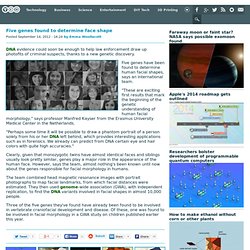
Five genes have been found to determine human facial shapes, says an international team. Genes for face shape identified. 13 September 2012Last updated at 18:34 ET MRI images were used to quantify the metrics of face shape ahead of the genetic study Understanding the genes that determine human facial shape could one day provide valuable information about person's appearance using just their DNA.
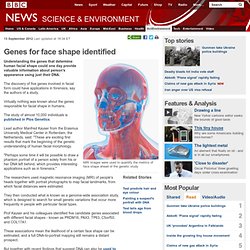
The discovery of five genes involved in facial form could have applications in forensics, say the authors of a study. Virtually nothing was known about the genes responsible for facial shape in humans. The study of almost 10,000 individuals is published in Plos Genetics. Forensic test can predict hair and eye colour from DNA. 24 August 2012Last updated at 08:42 ET By Paul Rincon Science editor, BBC News website.
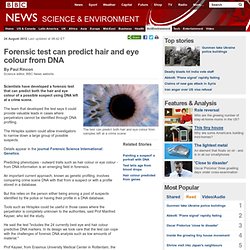
Test tells age from blood drops. 23 November 2010Last updated at 17:10 The technique relies on a property of immune cells carried in the blood Scientists have developed a technique to estimate the age of a suspect from blood left at a crime scene.
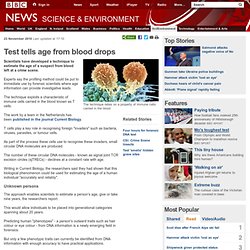
Experts say the profiling method could be put to immediate use by forensic scientists where age information can provide investigative leads. The technique exploits a characteristic of immune cells carried in the blood known as T cells. The work by a team in the Netherlands has been published in the journal Current Biology. T cells play a key role in recognising foreign "invaders" such as bacteria, viruses, parasites, or tumour cells. As part of the process these cells use to recognise these invaders, small circular DNA molecules are produced.
5 face-shaping genes identified - Technology & science - Science - LiveScience. Researchers have identified five of the genes that shape a person's face, work that could help scientists better understand facial abnormalities such as cleft palate and someday might even help forensic investigators determine what a criminal suspect looks like from crime-scene DNA.
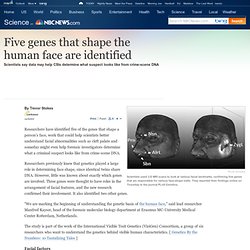
Researchers previously knew that genetics played a large role in determining face shape, since identical twins share DNA. However, little was known about exactly which genes are involved. Three genes were thought to have roles in the arrangement of facial features, and the new research confirmed their involvement. 5 Face-Shaping Genes Identified. Researchers have identified five of the genes that shape a person's face, work that could help scientists better understand facial abnormalities like cleft palate and someday might even help forensic investigators determine what a criminal suspect looks like from crime-scene DNA.

Researchers previously knew that genetics played a large role in determining face shape, since identical twins share DNA. However, little was known about exactly which genes are involved. Genetics by the Numbers: 10 Tantalizing Tales. Pigeons Recognize Human Faces. If you shoo a pigeon, that bird is likely to remember you and know to stay out of your way the next time you cross paths, according to a new study.
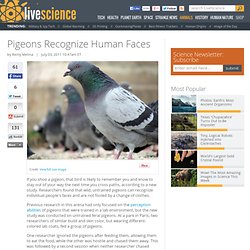
Wide-Faced Men More Aggressive. Men with big mugs are more aggressive, a new study of hockey players suggests.
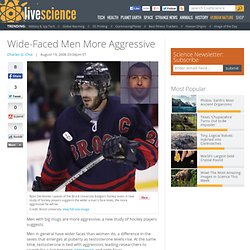
Men in general have wider faces than women do, a difference in the sexes that emerges at puberty as testosterone levels rise. At the same time, testosterone is tied with aggression, leading researchers to search for a link between aggression and wide faces. Canadian scientists investigated photos of pro and varsity hockey players, measuring how wide and long their faces were. They found the wider that faces looked, the more aggressive players were, as measured by the number of penalty minutes they accrued, which are handed out for aggressive behavior. "One great thing about hockey is that you're able to display aggressive behavior in an acceptable manner. In addition, the researchers tested 88 college students for aggression with a computer game where they were told they were matched against an opponent of the same sex, who in reality was just the computer. Facial Shapes Outlined With Five Genes.
September 14, 2012 Lawrence LeBlond for redOrbit.com – Your Universe Online If you have ever stared at yourself in the bathroom mirror wondering why your face looks the way it does, then this story is for you.
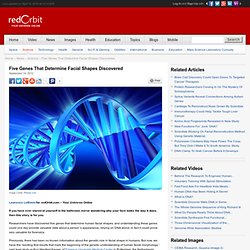
New Tool Will Allow Genome-Wide Association Studies - Health News. February 26, 2009 AssociationViewer will explore links between genes and disease Modern genotyping technologies offer new opportunities to explore how genes influence health and disease, but also present the challenge of analyzing huge amounts of genetic and clinical data.
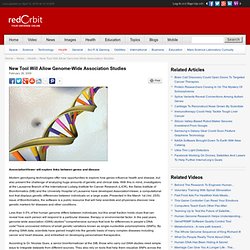
With this in mind, investigators at the Lausanne Branch of the international Ludwig Institute for Cancer Research (LICR), the Swiss Institute of Bioinformatics (SIB) and the University Hospital of Lausanne have developed AssociationViewer, a computational tool that displays genetic differences between individuals on a large scale. Presented in the March 1st (Vol. 25/5) issue of Bioinformatics, the software is a public resource that will help scientists and physicians discover new genetic markers for diseases and other conditions. According to Dr. Dr. “The software was developed on the principle that a picture is worth a thousand words,” says the study’s senior author, Dr. On the Net: DNA Test Determines Hair And Eye Color. August 26, 2012 Lawrence LeBlond for redOrbit.com – Your Universe Online The next time you leave your DNA behind be forewarned that you are now not only leaving your biological fingerprint behind for prying eyes, but also leaving evidence of what color your hair and eyes are.
Until the mid-1980s, DNA at a crime scene went largely unchecked due to lack of technology to search it out. A Genome-Wide Association Study Identifies Five Loci Influencing Facial Morphology in Europeans. Abstract Inter-individual variation in facial shape is one of the most noticeable phenotypes in humans, and it is clearly under genetic regulation; however, almost nothing is known about the genetic basis of normal human facial morphology. We therefore conducted a genome-wide association study for facial shape phenotypes in multiple discovery and replication cohorts, considering almost ten thousand individuals of European descent from several countries. Phenotyping of facial shape features was based on landmark data obtained from three-dimensional head magnetic resonance images (MRIs) and two-dimensional portrait images. We identified five independent genetic loci associated with different facial phenotypes, suggesting the involvement of five candidate genes—PRDM16, PAX3, TP63, C5orf50, and COL17A1—in the determination of the human face.
Author Summary Figures Editor: Greg Gibson, Georgia Institute of Technology, United States of America Copyright: © Liu et al. Introduction Results Table 1. FetchObject.action (PNG Image, 320 × 859 pixels) FetchObject.action (PNG Image, 401 × 600 pixels) FetchObject.action (PNG Image, 320 × 636 pixels) Erasmus MC: University Medical Center Rotterdam. Forensische Moleculaire Biologie. Erasmus MC Forensische Moleculaire Biologie: Estimating human appearance from DNA. Understanding the genetic basis of human appearance is a fascinating scientific area but surprisingly little is known thus far. In a forensic context, retrieving information on externally visible characteristics of a sample donor solely from the crime scene sample can provide valuable information for finding unknown individuals who usually cannot be identified via conventional DNA profiling.
However, it is expected that many - if not all - externally visible characteristics are quantitative traits where different genes and also environmental factors can contribute to the phenotype. This troubles not only the search for underlying genes but also attempts to predict the traits. We are therefore concentrating on unveiling the genetic basis of human appearance using, amongst other techniques, the genome-wide association approach. Erasmus MC Forensische Moleculaire Biologie: Introduction.
Welcome to the Department of Forensic Molecular Biology of the Erasmus MC University Medical Center Rotterdam The Department of Forensic Molecular Biology, established in 2004 as joined initiative of the Erasmus MC University Medical Center Rotterdam, the Erasmus University Rotterdam, and the Netherlands Forensic Institute (NFI), uses state-of-the-art technologies to address topics within human molecular biology and genetics that are of fundamental scientific interest and at the same time provide potential applications to forensic sciences.
A successful project i) deals with an important forensic question that currently cannot be answered, ii) starts with basic molecular research, iii) discovers new scientific information, iv) uses this knowledge to develop a new molecular test system, and v) finally delivers a forensically validated tool suitable for practical application to forensic case work, which answers the forensic question of interest. Selected recent publications: Police could create image of suspect's face from DNA - life - 14 September 2012. Police may one day be able to reconstruct the shape of a suspect's face from their DNA. The possibility is drawing closer thanks to identification of five genes that contribute to facial shape and features. DNA tests for predicting eye, hair and skin colour are currently available or under development, so identification of genes linked with facial features could help create a more detailed "Identi-Kit" picture purely from someone's DNA.
But the researchers caution that the genes they found only have small effects, and are only linked with a limited number of features, limiting their use until more genes of relevance are found. "It's a start," says Manfred Kayser from the Erasmus University Medical Center in Rotterdam, the Netherlands. "But we are far away from predicting what someone's face looks like. " Other identified genes influenced the distance from the eyes to the bridge of the nose, the length of the nose, and the facial width between cheekbones. Study reveals genes associated with facial shapes. Scientists use 3D MRI scans to look at various facial landmarks, confirming five genes that are responsible for various face-shape traits. Researchers have moved one step closer to facial reconstruction with DNA by discovering the genes that help control the width of the human face.
A recent study of almost 10,000 individuals revealed five genes associated with different facial shapes - known as PRDM16, PAX3, TP63, C5orf50, and COL17A1. Manfred Kayser and his team of the Erasmus University Medical Center in Rotterdam, the Netherlands, used Magnetic Resonance Imaging (MRI) of people's heads to map facial landmarks and estimate facial distances. The Visigen Consortium.